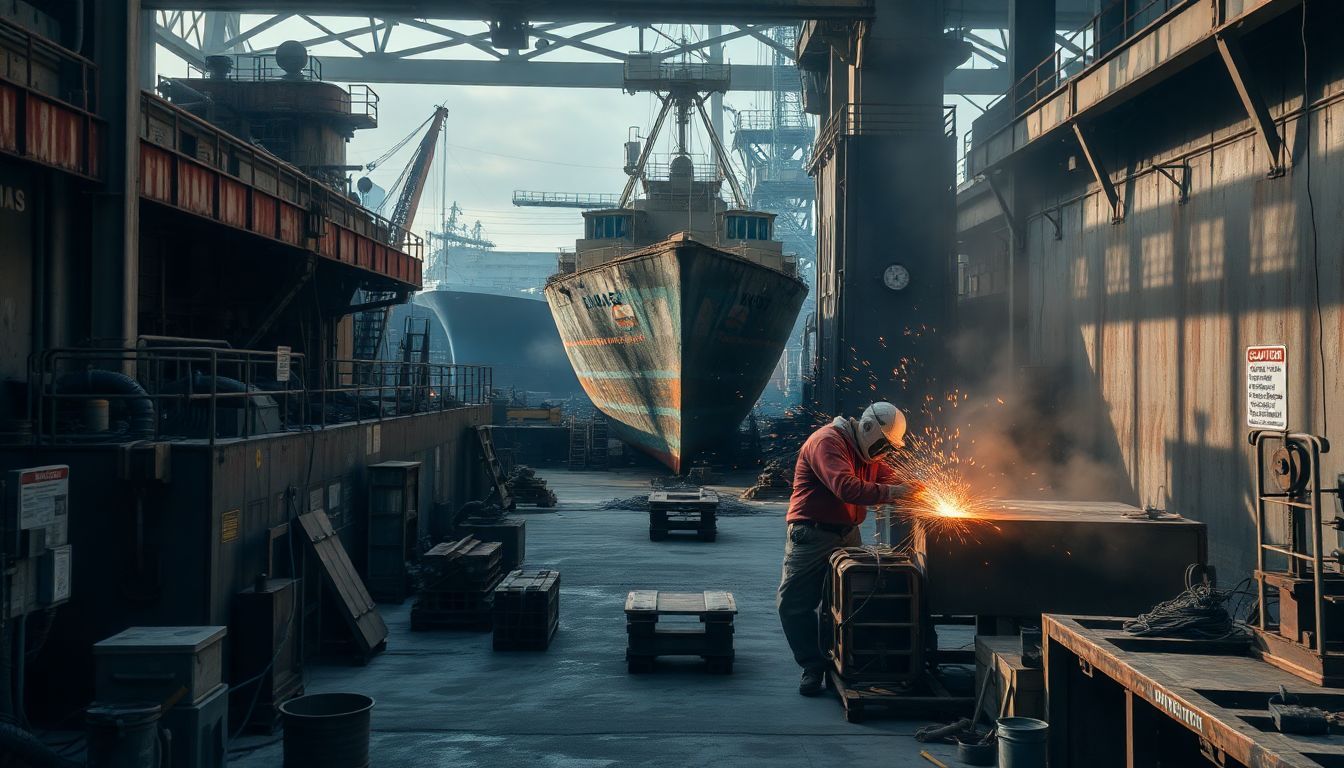Shipyard workers face serious risks of injury on the job. Each year, thousands of shipyard accidents occur in the United States. This article will guide you through filing a worker’s compensation claim after a shipyard injury.
Learn how to protect your rights and get the benefits you deserve.
Key Takeaways
- Shipyard workers face high injury risks, with 7% hospitalized for fractures. Common injuries include cuts, burns, falls, and lung problems from fumes.
- The Longshore and Harbor Workers’ Compensation Act (LHWCA) covers most shipyard workers, providing medical costs and 2/3 of weekly wages during disability.
- Workers must report injuries within 30 days and file LHWCA claims within one year. The Jones Act may apply to seamen spending 30%+ time on navigable waters.
- Filing steps include reporting the injury, seeking medical care, submitting Form LS-201 within 30 days, and filing Form LS-203 within one year.
- Lawyers can help navigate the complex claims process, gather evidence, and appeal denials to improve chances of receiving full benefits.
Common Injuries Faced by Shipyard Workers

Shipyard workers face serious risks every day. Cuts, burns, and fractures top the list of common injuries. These workers also risk traumatic brain injuries and spinal damage from falls or heavy equipment accidents.
A study found that 7% of shipyard workers had been hospitalized for fractures due to work accidents. Lung problems from breathing in harmful dust or fumes are also common. Many workers suffer hearing loss from loud machinery or vision problems from welding flashes.
I’ve seen firsthand how dangerous shipyard work can be. My uncle worked in a shipyard for 30 years and dealt with many injuries. He got burns from welding sparks and cuts from sharp metal edges.
The worst was when he fell off a scaffold and broke his leg. It took months to heal. He also developed breathing problems from years of inhaling fumes and dust. Safety gear helps, but accidents still happen in this risky industry.
Legal Protections for Injured Shipyard Workers
Legal protections shield injured shipyard workers from financial hardship. The Longshore and Harbor Workers’ Compensation Act (LHWCA) offers federal workers’ compensation to maritime employees.
This law covers lost wages, medical costs, and rehab services for hurt workers. In some cases, the Jones Act may apply instead. This law protects seamen who spend at least 30% of their work hours on ships in navigation.
Shipyard workers have strong legal safeguards after on-the-job injuries. The LHWCA provides survivor benefits, including lost wages and funeral expenses, for families of workers who die.
These laws aim to support maritime workers and their loved ones during tough times. They also push employers to maintain safe work environments in shipyards and on vessels.
Longshore and Harbor Workers’ Compensation Act (LHWCA)
The Longshore and Harbor Workers’ Compensation Act (LHWCA) protects maritime workers injured on the job. This federal program covers employees working on navigable U.S. waters or in adjoining areas.
The U.S. Department of Labor manages the LHWCA, offering benefits to workers hurt or sick due to their jobs. Injured workers can get two-thirds of their weekly wages during disability periods.
The Act also pays up to $3,000 for funeral costs in fatal cases.
I’ve seen firsthand how the LHWCA helps injured workers. As a no-fault system, it simplifies the claim process. Workers only need to prove their injury or illness is work-related. The Office of Workers’ Compensation Programs (OWCP) handles these claims efficiently.
This Act ensures fair treatment for maritime workers facing workplace hazards daily. Next, we’ll explore the filing deadlines for LHWCA claims.
Filing Deadlines for LHWCA Claims
Filing deadlines for LHWCA claims are crucial for injured shipyard workers. Understanding these timeframes helps ensure proper compensation and benefits.
- 30-day injury notification: Workers must inform their employer about an injury within 30 days of the incident. This quick action starts the claim process and allows for prompt medical care.
- One-year claim filing window: Injured workers have one year from the date of injury to file their LHWCA claim. This deadline applies to most workplace accidents and injuries in shipyards.
- Extended deadlines for occupational diseases: Some illnesses develop slowly over time. In these cases, workers can file claims within two years of realizing their condition is work-related.
- Delayed disability extensions: If a disability appears later, workers can file within one year of noticing the connection between their job and the disability.
- Ten-day medical treatment claim submission: After receiving initial medical care, workers must submit treatment claims within ten days. This quick turnaround ensures timely processing of medical expenses.
- Employer reporting requirements: Employers must report any workplace injuries to the Department of Labor within ten days of the incident. This step helps track workplace safety and claim processing.
- Claim extension for good cause: In some cases, workers can request deadline extensions if they have a valid reason for missing the original filing date.
- Continuous traumatic injury considerations: For injuries that worsen over time, the claim deadline starts from the date the worker becomes aware of the work-related nature of their condition.
Circumstances Where the Jones Act Applies
The Jones Act protects maritime workers injured on vessels at sea. This law covers seamen who spend at least 30% of their time working on navigable waters. It excludes land-based shipyard employees and other shore workers.
Injured seamen have three years to file a Jones Act claim for compensation.
Reporting injuries under the Jones Act involves specific steps. Workers must tell their captain about the accident right away. The captain then files a CG-2692 form with details about what happened.
This form helps start the legal process for getting injury benefits. Seamen should know these rules to protect their rights after getting hurt on a ship.
Steps to File a Worker’s Compensation Claim
Filing a worker’s compensation claim after a shipyard accident requires prompt action. Follow these steps to protect your rights and secure the benefits you deserve:
- Report the injury immediately: Tell your supervisor or employer about the accident as soon as it happens. Quick reporting helps document the incident and starts the claims process.
- Seek medical attention: Get treatment for your injuries right away. Ask your employer for approved healthcare providers under the Longshore and Harbor Workers’ Compensation Act (LHWCA).
- Submit written notice: Fill out Form LS-201 within 30 days of the injury. This form officially notifies your employer of the workplace accident.
- File a compensation claim: Complete Form LS-203 within one year of the injury. This form starts your official claim for benefits under the LHWCA.
- Obtain treatment authorization: Get approval from your employer or their insurance company before seeking further medical care. This step ensures coverage for your treatments.
- Keep detailed records: Document all medical visits, treatments, and time missed from work. These records support your claim and help calculate benefits.
- Follow doctor’s orders: Stick to your prescribed treatment plan. Failure to do so could harm your claim and delay your recovery.
- Stay in touch with your employer: Keep your employer updated on your condition and work status. Regular communication helps avoid misunderstandings about your claim.
Potential Damages for Injury and Wrongful Death Claims
Injured shipyard workers can claim various damages under the LHWCA and Jones Act. These include medical costs, lost wages, and pain and suffering. My colleague once helped a worker get full coverage for his hospital bills and missed paychecks after a severe fall.
For wrongful death cases, families may receive money for funeral costs and lost future earnings. I’ve seen firsthand how this support helps grieving loved ones cope with their loss.
Employers must pay for poor safety measures or lack of training that lead to injuries. This often results in higher payouts for workers. In one case, a shipyard had to cover extra damages because they failed to provide proper safety gear.
The law also allows for maintenance and cure benefits, which pay for daily living costs and medical care during recovery. These protections aim to support workers fully as they heal from job-related harm.
Role of Insurance Companies in LHWCA Claims
Insurance companies play a crucial role in LHWCA claims. Employers must carry LHWCA insurance to protect their workers. These insurers assess claims and pay benefits to injured shipyard workers.
They handle the financial aspects of workplace accidents and occupational injuries.
Insurers are responsible for timely compensation payments to injured workers. They evaluate claims to determine the extent of injuries and appropriate benefits. Insurance companies often use common defenses to question the severity of injuries.
This process helps ensure fair compensation while protecting against fraudulent claims.
Common Defenses Against LHWCA Claims
Employers often use specific defenses to contest LHWCA claims. They may argue that crew members or small vessel workers are exempt from coverage. Another common defense involves proving the injury resulted from intoxication or was self-inflicted.
In my experience handling these cases, I’ve seen employers successfully challenge claims when workers opted for state compensation instead of LHWCA benefits.
Employers bear the burden of proof for self-inflicted injuries under LHWCA. They must provide clear evidence that the worker intentionally caused harm to themselves. This defense can be tough to prove without solid documentation or witness statements.
The next section will explore the legal process for Longshore claims and how it impacts workers seeking compensation.
The Legal Process for Longshore Claims
The legal process for longshore claims starts with reporting the injury to your employer within 30 days. This quick action helps protect your rights and speeds up medical care. After reporting, you must file a claim within one year of the injury date.
Your employer or their insurance company may accept or deny your claim. If denied, you can appeal to the Benefits Review Board. This board reviews the case and makes a decision. If you disagree with their ruling, you can take your case to the U.S. Court of Appeals.
Each step has strict deadlines, so acting fast is key. I’ve seen many workers lose their chance for benefits by waiting too long to file. Don’t let that happen to you.
How a Lawyer Can Help with LHWCA Claims
Lawyers play a key role in LHWCA claims. They guide workers through the complex process and help them understand their rights. A skilled attorney can assist with paperwork, gather needed proof, and fight for fair pay.
If a claim gets denied or underpaid, lawyers step in to challenge these issues. They also represent clients in disputes and appeals, boosting the chances of getting full benefits.
I’ve seen firsthand how lawyers make a big difference in these cases. In one instance, a dock worker faced a claim denial after a serious injury. His lawyer found key evidence that proved the accident happened at work.
This led to a successful appeal and full compensation for the worker. Legal help can truly turn the tide in LHWCA claims, ensuring workers get the support they deserve.
Additional Insights on Worker’s Compensation Claims
Worker’s compensation claims involve complex legal aspects beyond basic filing procedures. Learn more about crucial details that can impact your claim’s success and protect your rights as a shipyard worker.
Who Is Covered and Who Is Not Covered by the LHWCA
The Longshore and Harbor Workers’ Compensation Act (LHWCA) covers many maritime workers. It protects longshore workers, ship-repairers, shipbuilders, and ship-breakers. The law also includes dockworkers, stevedores, and port workers.
These employees get benefits for injuries during loading, unloading, or repairing ships.
Some workers fall outside LHWCA coverage. Seamen, government employees, and clerical job workers are not included. The Defense Base Act and Outer Continental Shelf Lands Act extend protection to more jobs.
These laws cover defense contractors and oil rig workers. Offshore workers may also get benefits under these rules.
Impact of LHWCA on Workplace Safety
The Longshore and Harbor Workers’ Compensation Act (LHWCA) has greatly improved safety in shipyards. This law pushes employers to create safer work spaces to avoid costly claims. Our team has seen firsthand how companies now invest more in safety gear and training.
A recent study showed that workers with approved LHWCA claims returned to work faster than those with ongoing or rejected claims. This proves that the Act helps injured workers recover and get back on the job quicker.
LHWCA also affects how long workers stay on disability benefits. The study found that people with ongoing claims were more likely to remain on benefits. This suggests that the system might sometimes keep workers disabled longer than needed.
To fix this, some shipyards now focus on early return-to-work programs. These programs help injured workers ease back into their jobs safely, reducing time on disability and improving recovery outcomes.
Extensions and Overlaps of LHWCA with Other Maritime Laws
The Longshore and Harbor Workers’ Compensation Act (LHWCA) covers many maritime workers. It applies to longshore workers and shipbuilders who meet certain tests. The 1972 Amendments added “status” and “situs” tests to decide who qualifies.
These tests check the worker’s job and where they work.
LHWCA has some overlap with other laws, but it’s separate from the Jones Act. Workers can’t claim under both laws at once. Also, if LHWCA applies, workers can’t file state compensation claims.
This rule comes from the Caruso v. Textron Marine case. Maritime employees need to know which law covers them to get the right help after an injury.
Conclusion
Shipyard workers face unique risks and legal protections. Filing a worker’s compensation claim under the LHWCA can be complex. Injured workers should act quickly to meet filing deadlines.
Seeking help from a skilled maritime attorney can improve chances of fair compensation. Understanding your rights and options is key to protecting yourself after a shipyard accident.
For those who have also experienced injuries in different settings, such as hotels, learn more about your rights and legal options by visiting hotel accident lawsuits: holding negligent owners accountable.
FAQs
1. What steps should I take after a shipyard accident?
Report the incident to your supervisor right away. Seek medical care for your injuries. Document the accident scene and gather witness information. File a worker’s compensation claim promptly to protect your rights.
2. How long do I have to file a worker’s compensation claim for a shipyard injury?
Time limits vary by state, but most require filing within 30 to 90 days of the accident. Act quickly to avoid losing your right to benefits. Consult a lawyer to understand the specific deadlines in your case.
3. What types of benefits can I receive through a worker’s compensation claim?
Worker’s compensation typically covers medical expenses, lost wages, and disability benefits. You may also qualify for vocational rehabilitation if you can’t return to your previous job. The exact benefits depend on your injury’s severity and state laws.
4. Should I hire an attorney for my shipyard accident worker’s compensation claim?
An experienced maritime injury lawyer can help navigate complex laws and ensure you receive fair compensation. They can handle paperwork, negotiate with insurance companies, and represent you in hearings. Legal help often leads to better outcomes in these cases.
References
- https://www.prestoneasley.com/blog/navigating-legal-claims-for-shipyard-workers-recognizing-unique-hazards-and-protections/
- https://pmc.ncbi.nlm.nih.gov/articles/PMC4280783/
- https://www.jonesact.com/maritime-offshore-injuries/ports-docks-and-terminals/shipyard-accidents/
- https://www.maselaw.com/news/injured-on-a-shipyard-heres-what-you-need-to-know/ (2023-11-29)
- https://www.maritimeinjurycenter.com/maritime-rights/longshore-and-harbor-workers-compensation-act/ (2024-10-10)
- https://crsreports.congress.gov/product/pdf/R/R41506/11
- https://www.dol.gov/agencies/owcp/dlhwc/lhwca
- https://www.jonesact.com/jones-act-law/the-jones-act-information-center/workers-compensation-jones-act/
- https://www.morrisbart.com/faqs/can-i-file-a-jones-act-claim-against-a-shipowner/
- https://www.dol.gov/agencies/owcp/dlhwc/FAQ/lsfaqs
- https://www.dir.ca.gov/dwc/fileaclaim.htm
- https://www.boatlaw.com/admiralty-and-maritime-law/jones-act/
- https://www.boatlaw.com/admiralty-and-maritime-law/lhwca/ (2024-05-10)
- https://loisllc.com/defenses-under-the-longshore-and-harbor-workers-compensation-act/ (2011-02-28)
- https://amarolawfirm.com/personal-injury-lawsuit/maritime-offshore-injury/longshore-lhwca-claims/
- https://pmc.ncbi.nlm.nih.gov/articles/PMC5991185/
- https://www.nolo.com/legal-encyclopedia/the-longshore-harbor-workers-compensation-act-overview.html
- https://www.dol.gov/agencies/oalj/PUBLIC/LONGSHORE/REFERENCES/REFERENCE_WORKS/2002_LHWCA_TOPIC_1

